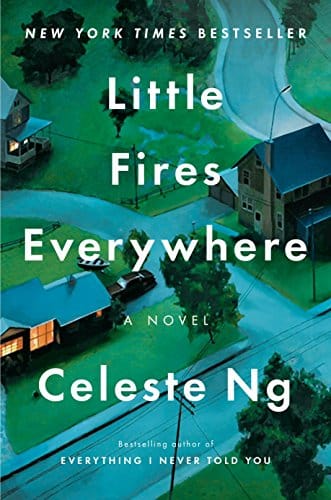Little Fires Everywhere: A Deep Dive into Celeste Ng’s Smoldering Masterpiece
Explore the themes, characters, and cultural impact of Celeste Ng's "Little Fires Everywhere," the bestselling novel and hit Hulu series that challenge ideas of privilege and motherhood.

Introduction
Celeste Ng’s 2017 bestselling novel "Little Fires Everywhere" captured readers by exposing the combustible mix of race, privilege, motherhood, and identity beneath the manicured lawns of suburban America. Set in the meticulously planned community of Shaker Heights, Ohio, the story follows two very different families whose lives collide, ignite, and ultimately burn down the illusion that there is a single correct way to live. In 2020, the Hulu limited series starring Reese Witherspoon and Kerry Washington took the narrative to television audiences, sparking renewed discussion about the book’s themes. This article offers an 800-word exploration of the plot, characters, motifs, and cultural impact of "Little Fires Everywhere," while remaining spoiler-light for new readers.
Plot Overview
The novel opens with Elena Richardson standing in front of her stately home as it blazes, lit on multiple fronts by her youngest daughter, Izzy. From this dramatic scene, Ng rewinds the narrative to trace how the Richardsons—an affluent white family—become entangled with Mia Warren, a nomadic artist, and her teenage daughter, Pearl. Mia rents an investment duplex owned by Elena, and the two mothers embody opposite worldviews: structure versus spontaneity, security versus freedom. Their children form friendships and rivalries that intensify when a local adoption case divides the town. The plot is propelled by a truth Ng underscores again and again: the smallest decisions—little fires—can lead to uncontrollable conflagrations.
Major Themes
Motherhood and Ownership
At the heart of "Little Fires Everywhere" is the question of what makes someone a mother. Is it biology, sacrifice, love, or legality? Elena believes stability and adherence to rules create good parents; Mia argues that unconditional devotion matters more than material comfort. The McCullough adoption case, which pits a well-off couple against a birth mother returning for her child, crystallizes this debate and forces every character to choose sides.
Privilege and Blind Spots
Ng deftly illustrates how privilege functions like an invisibility cloak. The Richardsons assume their opportunities stem from hard work alone, unaware of the systemic advantages guiding their path. Mia’s outsider status highlights the implicit contracts of Shaker Heights—unspoken codes about race, class, and behavior that favor those who already fit in. Through moments big and small, the novel asks readers to reflect on the privileges that often go unexamined.
Identity and Reinvention
Many characters attempt to reinvent themselves while wrestling with societal expectations. Mia adopts new towns, jobs, and photographic projects to outrun a painful past; Lexie Richardson molds her identity to appear perfect on college applications; Pearl experiments with belonging in both the Warren and Richardson households. Shaker Heights itself, meticulously zoned and regulated, stands as a metaphor for a controlled identity in perpetual denial of its cracks.
Character Analysis
Mia Warren
Mia serves as the novel’s moral compass and disruptor. A gifted photographer, she finances her art by taking odd jobs and living lightly, unburdened by material possessions. Her creative worldview nurtures Pearl’s imagination but also introduces instability. Mia’s secretive past, slowly unveiled, demonstrates the lengths a mother will go to protect her child, challenging readers to weigh her questionable choices against her unwavering love.
Elena Richardson
Elena embodies the rigid order of Shaker Heights. As a journalist and mother of four, she adheres to schedules, binders, and civic duty. Yet her quest for fairness masks a subconscious need to validate her life choices. Elena’s interactions with Mia expose deep insecurities and a patronizing impulse to “help” on her own terms, ultimately fueling the inferno that consumes her family.
Izzy Richardson
The youngest Richardson child, Izzy, feels perpetually misunderstood. Sensitive and passionate, she gravitates toward Mia’s unconventional aura, recognizing in the artist a model for authentic living. Izzy’s rebellion against her mother’s rules culminates in the literal little fires that frame the novel, making her both catalyst and symbol of the cost of suppressed individuality.
From Page to Screen
The 2020 Hulu adaptation expanded the novel’s audience while making deliberate changes. Casting Kerry Washington as Mia introduced an explicit exploration of race, whereas in the book Mia’s race is never stated. The series also lengthened certain backstories, giving Elena and Mia parallel flashbacks that underscore their contrasting decisions. While purists prefer the novel’s subtlety, many viewers praised the show for amplifying marginalized voices and modernizing the timeline to the late 1990s.
Cultural Impact
"Little Fires Everywhere" resonated at a cultural moment fixated on social justice and reckoning with privilege. Book clubs across the globe dissected its moral dilemmas, and high school curricula added the novel to reading lists for discussions on intersectionality. Online, the hashtag #LittleFiresEverywhere generated thousands of threads where parents debated adoption ethics and readers shared personal stories of belonging. By illuminating ordinary choices that sustain inequity, Ng gave the public vocabulary to interrogate everyday complicity.
Why the Story Still Matters
Five years after publication—and amid global movements demanding systemic change—Ng’s novel feels prescient. It encourages readers to question tidy facades, listen to marginalized voices, and recognize that well-intentioned actions can perpetuate harm. As climate change, political polarization, and economic disparity fuel literal and metaphorical fires, "Little Fires Everywhere" offers a cautionary tale: ignoring the sparks of dissent only guarantees a larger blaze.
Conclusion
Celeste Ng crafted more than a domestic drama; she delivered a layered narrative that forces readers to confront uncomfortable truths about privilege, parenting, and the blurred lines between right and wrong. Whether you pick up the novel, binge the series, or revisit both, "Little Fires Everywhere" will leave you reflecting on the small choices that shape our lives and the hidden embers smoldering beneath every orderly surface.



